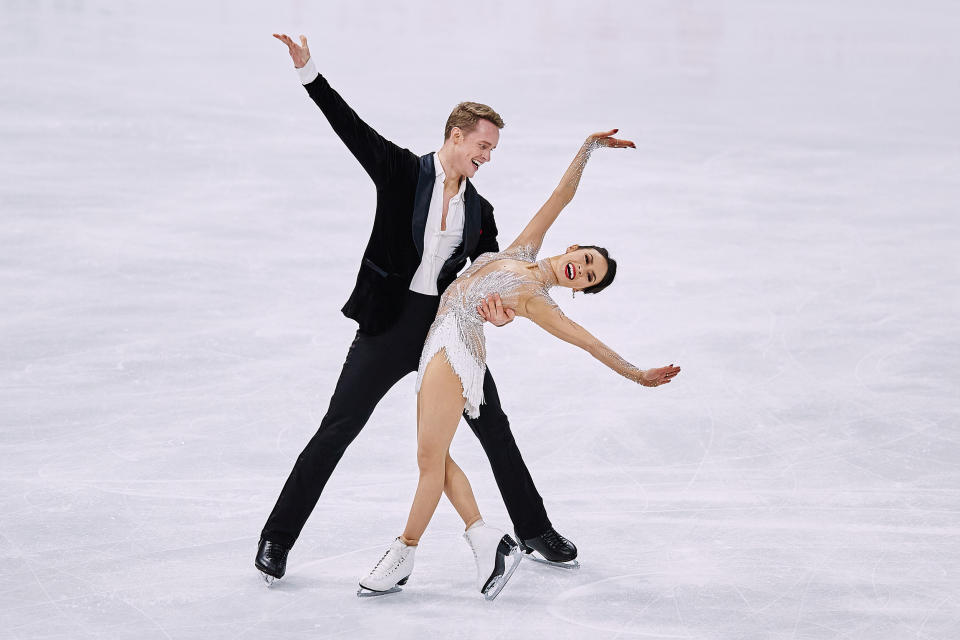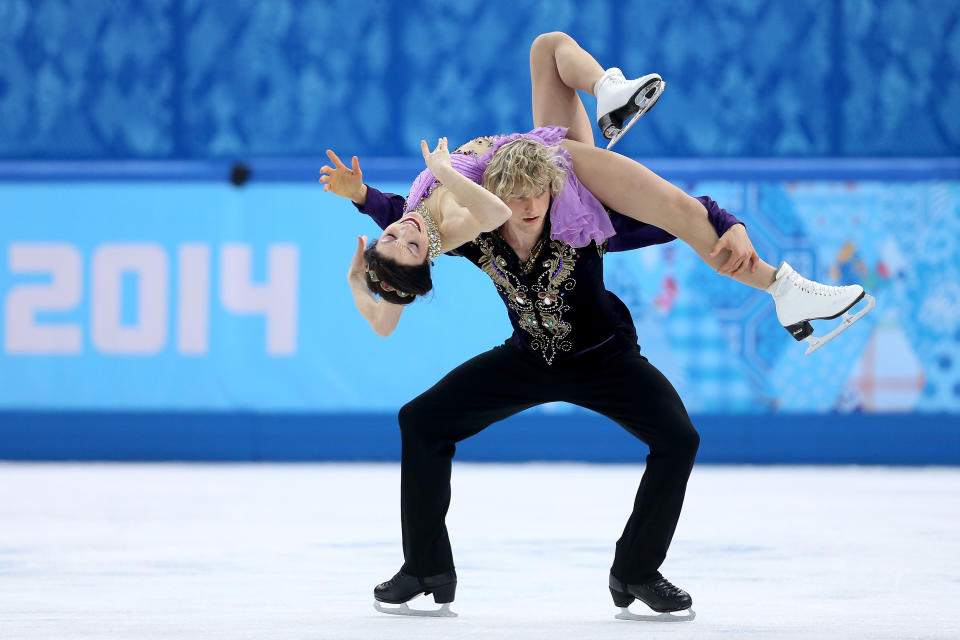What’s a twizzle? Your top ice dancing questions - answered by a silver medalist
- Oops!Something went wrong.Please try again later.
If you think of figure skating as gymnastics on ice, a mind-boggling and dizzying assortment of intricate spins, leaps, twirls, and jumps, then ice dancing is its more elegant ice-bound sibling. In fact, it’s the only figure skating event that actively bans jumps: Skaters can only perform singles, as opposed to the quads you see in singles’ skating. You also won’t see ice dancers delivering any overhead lifts, throw jumps, or anything else airborne.
Instead, when ice dancers compete at the 2022 Beijing Winter Olympics, the focus will be on refined togetherness — "think ballroom dancing meets Cirque du Soleil," says silver medalist Tanith Belbin White.
Team USA's ice dancers will be on-and-off-ice couple Madison Chock and Evan Bates in their third Olympics as a team, Madison Hubbell and Zachary Donohue in their second Olympics, and Kaitlin Hawayek and Jean-Luc Baker in their Olympic debuts.
To answer some of the most googled questions about ice dancing — like how do ice dancers stand on each other and not get cut? — we spoke with Belbin White, who with Ben Agosto was part of the first-ever U.S. ice dancing team to win a silver medal at the 2006 Olympics in Turin.
How is ice dancing different from figure skating?
Ice dancers are expected to be no more than two arms’ lengths apart. The key components of an ice dance are the twizzle (a complex moving turn on one foot), a pattern dance, lift, spin, step sequence and myriad choreographic elements.
“The ice dance event features two skaters working as a team to perform intricate maneuvers, steps, and acrobatics, all while staying in close contact throughout the program and with an emphasis on musicality and interpretation. Think ballroom dancing mixed with Cirque du Soleil, and you might get an idea of what to expect!” says Belbin White.

How do ice dancers stand on each other?
Surely, gravity aside, the blades would cut through skin? No, says Belbin, who calls this “one of the most common questions I get asked. First off, although skate blades are sharp, they’re perhaps not quite as sharp as some may think. Sure, slide your palm down a freshly sharpened blade and you could easily cut yourself but straight pressure down from a mostly flat blade is more likely to bruise, if anything at all,” she says.
And the costumes also play their part. “The fabric from costumes provides another layer of protection, in the case of the women standing on the man’s leg, which is a common type of ice dance lift,” says Belbin. “The rest is technique. If either partner is unstable or the timing in establishing the lift position is off, that’s when accidents can happen. Teams repeat the same lifts hundreds of times before they compete to ensure the blade is always in the same place, and the balance is reliably secure.”
Can ice dancers do jumps?
“No jumps in the ice dance competition, like what you see in singles and pairs skating. There are synchronized twizzles, however, which are the same number of rotations (or more) than a quadruple jump but the blades stay in contact with the ice while spinning through fast rotations at a high speed,” says Belbin.
Twizzles are a series of turns on one foot. The skaters perform the rotations quickly with a continuous action, side by side, preferably close to each other on the ice (though not touching).

How do ice dancers spin each other around without losing their balance?
Again, it’s a case of practice, practice, and more practice, because there’s very little margin for error. “In the case of a rotating lift, when one partner is spinning across the ice while holding the other off the ice, it has as much to do with momentum as it does timing and strength. Whether it be speed, or centrifugal force, or both depending on the type of lift, the team has to find the perfect moment to use all those factors to their advantage. Then, while in the lift, the lifting partner needs to spin fast enough to maintain that force,” says Belbin.
Who are the best ice dancers of all time?
Sure, Belbin White ranks among the greats, but the skater is happy to share the spotlight with other notables, including her husband, gold medalist Charlie White. “It’s almost impossible to give an entirely objective answer to that question because of the artistic quality of the sport — which, by the way, is also what I love most about it — but some of the biggest names in ice dance history are Marina Klimova and Sergei Ponomarenko, Jayne Torvill and Christopher Dean, Tessa Virtue and Scott Moir, and the first American Olympic gold medalists in the sport, Meryl Davis and Charlie White,” she says.

What’s the most difficult ice dancing move?
That’s entirely dependent on the team and the skater. “For some, it’s the acrobatics. For others, it’s skating closely together while navigating difficult turns and maneuvers, or expressing the program’s theme for an audience. Really, the biggest challenge is putting together a performance that’s as technically strong as it is artistically impactful. Those are the programs people remember forever,” says Belbin White.

What would surprise people watching ice dancing?
Skaters perform for four minutes, but it’s the culmination of a lifetime of grueling practice. They make it look easy. It’s not. Not even a little. It can take up to 10 hours for an average person (you or me) to even gain a sense of balance on the ice, never mind shimmying backwards or mastering a sit spin.
“Ice dancers will often spend the longest hours training any given day, compared with the other disciplines, because there’s really no limit to how much attention and refinement you can give every moment of the program. An audience member may not recognize the artistic impact of a tilt of the head, or how difficult it is look as though you’re flying across the ice effortlessly, but it’s those intangibles which create the most captivating performances,” says Belbin White.

